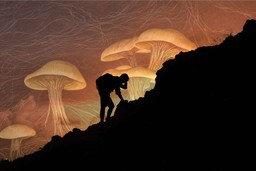A topic that is becoming increasingly important in the psychedelic industry is the risks of using these compounds and how best to address them. US states and countries around the world continue to relax laws surrounding psychedelics – either for medical or personal use. As this happens, there is greater concern about the possible harm that may occur when they are more easily available.
However, several figures in the psychedelic community are drawing attention to the extended difficulties following psychedelic use that can occur. The writer Jules Evans, for instance, has been focusing on this subject in his writing under two different projects. One is in the running of the website Ecstatic Integration. The other is through the Challenging Psychedelic Experiences Project, which carries out research related to difficulties related to psychedelics.
He and a team of researchers recently had an article published in PLOS ONE. The article was titled ‘Extended difficulties following the use of psychedelics: A mixed methods study’ [1]. It uncovered the most common forms of long-term distress after psychedelic use—as well as how long these difficulties can last. Let’s explore what extended difficulties mean, how this study was designed, and its valuable findings.
Resources to Help You Get Started
These are some resources that might be helpful:
- Take Our FREE Psychedelic Harm Reduction Course Riding the Wave
- Enroll now in our course, Five Steps for Responsible Preparation for Plant Medicine Journeys
- Follow Our Comprehensive Guide to Journey Safely With Magic Mushrooms
- Get The Course Now Journey Consciously Through Your Inner World
Extended Difficulties Following Psychedelic Use
There is growing evidence of the benefits of psychedelics. They can significantly improve people’s mental health, as well as potentially treat chronic pain conditions. However, the harms experienced after their psychedelic experiences and what helps people cope with these adverse effects are less researched. An ‘extended difficulty’ refers to one or more adverse effects—unwanted, negative, distressing experiences—outlasting the acute effects of a psychedelic trip. In Evans et al.’s recent study, ‘extended’ means lasting beyond 24 hours after the acute effects have subsided.
Despite a dearth of studies on challenging psychedelic experiences, more and more researchers are focusing on this issue. For example, results from the Global Ayahuasca Survey, published in PLOS Global Public Health, highlighted this. It showed that 12% of respondents reported lasting adverse effects following ayahuasca use [2]. The 2020 Global Drug Survey also covered this. It found that of those who practiced self-treatment with LSD and psilocybin, 6% reported difficulties lasting longer than a month [3].
The Study’s Aims and Design
In their study, Evans and fellow researchers wanted to investigate the types, phenomenology, perceived causes, and associated risk factors of enduring distress following psychedelic use. Regarding the types of distress—the focus of this article—the authors also studied the relative prevalence of these.
The study used what is known as a convergent mixed-methods design. This involves collecting quantitative and qualitative data about the phenomenon in question simultaneously. Then, the findings are presented in a combined report (based on the idea that these types of results complement each other).
Both the quantitative and qualitative data were gathered through an online survey. This survey was distributed via social media channels, a newsletter, email lists to students, and a newspaper advert. 608 individuals who had experienced difficulties after taking a psychedelic drug completed the survey (anonymously). They were asked to answer a series of open-ended and closed-ended questions. In terms of the range of difficulties someone might have experienced, the following categories were utilized:
- Emotional
- Self-perception
- Cognitive
- Social
- Ontological
- Spiritual
- Perceptual
- Other
Common Types of Extended Difficulties
The researchers were able to identify common themes reported in the participants’ written accounts of extended difficulties following psychedelic use:
- 76%: emotional difficulties (e.g., the way you felt emotionally or the ability you had to emotionally regulate)
- 58%: self-perception difficulties (e.g., the way you felt about or understood yourself)
- 52%: cognitive difficulties (e.g., the way you thought about things)
- 52%: social difficulties (e.g., the way you related to other people)
- 50%: ontological difficulties (e.g., the way you understood reality and existence)
- 34%: spiritual difficulties (e.g., your spiritual beliefs)
- 26%: perceptual difficulties (e.g., the way your vision or hearing functioned)
- 21%: other difficulties
The authors state, “The most common forms of extended difficulty were feelings of anxiety and fear, existential struggle, social disconnection, depersonalization, and derealization. For approximately one-third of the participants, problems persisted for over a year, and for a sixth, they endured for more than three years. It was found that a shorter duration of difficulties was predicted by knowledge of dose, drug type, and lower levels of difficulty reported during the psychoactive experience, while a narrower range of difficulties was predicted by taking the drug in a guided setting. Implications for psychedelic harm reduction are discussed.”
“The most common forms of extended difficulty were feelings of anxiety and fear, existential struggle, social disconnection, depersonalization, and derealization.”
Extended difficulties following the use of psychedelics: A mixed methods study
What Do These Types of Extended Difficulties Feel Like?
Each type of these extended difficulties following psychedelic use also had a most common subtype. The study’s authors included various quotes from respondents that encapsulate the various subtypes.
Social Difficulties
The most commonly reported type of social difficulty was a sense of social disconnection. One respondent described this as follows: “A feeling of being distant, withdrawn, ’socially outcast’… Even from other Ayahuasca users.” Other subtypes of social difficulty included:
- Communication difficulties (related to talking to others or understanding them)
- A sense of social stigma (feeling ashamed about the experience and hence not talking about it)
- Social anxiety (a heightened fear of being judged by others)
- Hurt by the behavior of others (such as a guide during a ceremony)
- Social withdrawal (a more extreme form of social disconnection)
- Difficulty with being socially normal (struggling to fit in and be ‘normal’)
Perceptual Difficulties
The most common type of perceptual difficulty reported was visual distortions/hallucinations. This included phenomena seen in hallucinogen persisting perception disorder (HPPD). Examples of these are visual snow syndrome, visual distortions, seeing tracers, and extreme sensitivity to light. ‘Flashback’ was included under this category, which involves feeling like the trip is repeating, sometimes sounding like a traumatic response.
The perceptual difficulties theme also included the sub-theme of auditory distortions/hallucinations. For example, this includes increased sensitivity to noise, auditory distortions like buzzing, and hearing voices.
Other sub-themes were also identified. One of these was non-specific sensory distortions/hallucinations, which included tactile, taste, and olfactory distortions or hallucinations. Time distortions, referring to extended distortions to one’s sense of time, were also found. One person said that for up to a week after their experience, “everything felt like it was moving a lot slower than it should’ve, and this caused me to think I was going crazy, leading to stress and low mood.”
Cognitive Difficulties
The most common type of cognitive difficulty was confusion/problems with thinking clearly. One respondent said, “I couldn’t think or speak linearly for at least a few days, or at least it felt that way… Everything felt confusing, and I didn’t know if or when it was going to end… I didn’t understand what was happening to me and did not have any language for it.”
The other subtypes of cognitive difficulty were:
- Intrusive, ruminative, or obsessive thoughts
- Forgetfulness/memory issues
- Difficulty with concentration
- Difficulty with making decisions
Emotional Difficulties
When it came to emotional difficulties, the most common type was anxiety/fear. As one participant reported: “For about 18 months, I awoke with the sun every morning full of a feeling of absolute terror… Sometimes my anxiety would be so high in the morning that I would physically shake from the energy.”
There were many varieties of anxiety and fear, including:
- Paranoia
- Panic attacks
- Social anxiety
- Fear of the experience repeating
- Fear of losing control or going mad
- Fear of being alone with one’s own mind
- Other forms of phobia (such as agoraphobia)
- Fear of dying (especially common if respondents felt they were dying during the trip)
- Fear of permanent damage (such as the fear of one’s brain being broken)
- Feeling vulnerable or unsafe in one’s own mind
Other subtypes of emotional difficulty included:
- Depression
- Low mood/anhedonia
- Challenging or overwhelming emotion
- Anger/irritability
- Hyperarousal/feeling unable to relax/hyper-vigilance or emotional sensitivity
- Suicidality
- Guilt/shame
- Resurfaced trauma
- Feelings of disappointment (because the ‘miracle cure’ they hoped for did not materialize)
Existential and Ontological Difficulties
Existential struggle was the most common type of existential and ontological difficulty. This involved struggling to make sense of psychedelic experiences or reality in general. Other subtypes included derealization, referring to confusion or uncertainty over what is real. Respondents sometimes felt they were in a dream, afterlife, purgatory, a movie, a computer game, or a fake reality. Derealization was often accompanied by depersonalization (the feeling of being outside yourself and observing your actions).
Other sub-themes of existential and ontological difficulties included:
- Sense of hostile/impersonal reality
- Sense of hell/evil presence/fear of the afterlife
- Possession (feeling possessed by a spirit or energy)
- Magical/delusional beliefs
- Despair over the state of the world or the human race
- Struggle to integrate the experience and return to daily life
Self-Perception Difficulties
Depersonalization was the most common variety of self-perception difficulty. Other sub-themes discovered were diminished or disempowered self (e.g., feeling less confident and worse about oneself) and excessive self-consciousness or self-awareness.
The authors make some specific recommendations based on the prevalence of these types of extended difficulties following psychedelic use. However, they note how the range of possible negative outcomes can make informed consent challenging “Given that anxiety and fear are some of most common kinds of difficulties, we propose that all legal providers of psychedelic experiences provide a guidance document on methods for self-soothing and overcoming bouts of anxiety following the retreat, clinical trial or ceremony. The variety of possible adverse outcomes presents a challenge for informed consent for psychedelic clinics and retreat centers. Patients and participants should be informed what sorts of harms can occur, the relative risks of these, and advised that the integration process can take months. They could also be informed about some of the practices that help people cope with difficulties, which we explore in a forthcoming paper.”
Follow your Curiosity
Sign up to receive our free psychedelic courses, 45 page eBook, and special offers delivered to your inbox.References
- Evans, J., Robinson, O.C., Argyri, E.K., Suseelan, S., Murphy-Beiner, A., McAlpine, R., Luke, D., Michelle, K., and Prideaux, E. (2023). Extended difficulties following the use of psychedelic drugs: A mixed methods study. PLOS ONE, 18(10): e0293349.
- Bouso, J.C., Andión, Ó., Sarris, J.J., Scheidegger, M., Tófoli, L.F., Opaleye, E.S., Schubert, V., and Perkins, D. (2022). Adverse effects of ayahuasca: Results from the Global Ayahuasca Survey. PLOS Global Public Health, 2(11): e0000438.
- Kopra, E.I., Ferris, J.A., Winstock, A.R., Kuypers, K.P., Young, A.H., and Rucker, J.J. (2023). Investigation of self-treatment with lysergic acid diethylamide and psilocybin mushrooms: Findings from the Global Drug Survey 2020. Journal of Psychopharmacology, 37(7), 733-748.







